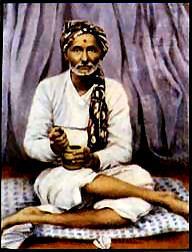Died 1914, India | ||
 | ||
Bhausaheb Maharaj (1843-1914) was the founder of the Inchegeri Sampradaya, to which the well-known Indian guru Nisargadatta Maharaj belongs.
Contents
Background
Bhausaheb Maharaj was born in 1843 as Venkatesh Kanderao Deshpande. Bhausaheb Maharaj belonged to the Deshastha Brahmin caste, the same caste to which the thirteenth century Varkari saint and philosopher Dnyaneshwar belonged, the 16th century sant Eknath, and the 17th century saint and spiritual poet Samarth Ramdas. Dnyaneshwar was universally acclaimed for his commentary on the Bhagvad Gita. Eknath published an extensive poem called the Eknathi Bhagwat in the 16th century. Other works of Eknath include the Bhavartha Ramayana, the Rukmini Swayamwara and the Swatma Sukha. Samarth Ramdas, who was also the spiritual adviser to Shivaji, wrote the Dasbodh.
Spiritual life
According to Kotnis, Bhausaheb Maharj was looked upon as the reincarnation of Sant Tukaram (1577–1650), a prominent Varkari Sant and spiritual poet of the Bhakti, who had taken birth again in the Neelwani Lingayat community to finish his work of spreading the knowledge of Self-realisation. He met his guru Sri Nimbargi at the age of fourteen. At the request of Nimbargi, Bhausaheb Maharaj Deshpande (1843 Umdi - 1914 Inchgiri) received mantra initiation from Shri Raghunathpriya Sadhu Maharaj, who was an ardent follower and a devoted disciple of Shri Gurulingajangam Maharaj. Bhausaheb Maharaj became a disciple of Nimbargi Maharaj.
The Ant's Way
Bhausaheb Maharaj's teachings, and those of his student Gurudeo Ranade, have been called Pipilika Marg , "the Ant's way", the way of meditation, while the teachings of his student Siddharameshwar Maharaj, and Siddharameshwar Maharaj's disciples Nisargadatta Maharaj and Ranjit Maharaj have been called Vihangam Marg, "the Bird's Way", the direct path to Self-discovery. Ranjit Maharaj comments:
There are two ways to realize: the bird's way or ant's way. By meditation (or ant's way) one can realize. The word or name has so much power. The name you were given by your parents has done so many things. Mantra is given by the master, but it is a very long way for the understanding. By chanting or saying the mantra you can go to the final reality.There are only two things: one is reality, the other is illusion. One word only can wipe out illusion.
So one thought [i.e. mantra] from the Master who has realized is sufficient to realize. It is a very lengthy way, that's the only thing. So my Master found the shortest way, by thinking. By unthinking you have become the smallest creature, and by thinking you can become the greatest of the great, why not? If you don't have the capacity to understand by thinking, the bird's way, then you can go by way of meditation. It is the long way and you have to meditate for many hours a day. People say they meditate, but most don't know how to meditate. They say that God is one and myself is another one, that is the duality. It will never end that way.
So one word is sufficient from the Master. Words can cut words, thoughts can cut thoughts in a fraction of a second. It can take you beyond the words, that is yourself. In meditation you have to eventually submerge your ego, the meditator, and the action of the meditation, and finally yourself. It is a long way.
Nama-Yoga
Bhausaheb Maharaj teachings were collected in a book called Nama-Yoga, a term coined by the compilers and translators of the book, whereas Bhausaheb Maharaj himself called it Jnana Marga, just like Nimbargi Maharaj did. The editors wrote:
"Nama-Yoga" is a word specially coined by us to designate the Spiritual Philosophy and Discipline of Sri [Bhausaheb] Maharaj. He himself called it Jnana-Marga - or Path of self-realisation. We have , however, used "Nama-Yoga" in a double sense. In fact, both the words - Nama and Yoga carry double meaning. Nama means i)Meditation on Divine Name and ii) Divinity in posse. Like many other saints, to Sri [Bhausaheb] Maharaj also, Nāma (name) and Rūpa (form) of God were identical. The Name itself was God. Yoga means Spiritual union or realisation of god. In the first sense, Nama-Yoga represents the Path, while in the second sense, it represents the Goal, as meditation, on Divine Name, if properly practiced, will lead to the realisation of the vision and bliss of the lord.
Lineage
After his awakening he was authorized by Nimbargi to carry on the lineage, and established the Inchegeri Sampraday. Sri Bhausaheb Maharaj had many students, among which were:
